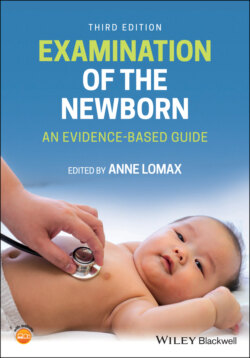Читать книгу Examination of the Newborn - Группа авторов - Страница 44
Parental dialogue and involvement with the newborn assessment process
ОглавлениеWomen and their partners may already have concerns about their newborn at the start of the examination. These concerns may have a physical or behavioural focus. The history‐taking process must include discussion with the parents, if present, prior to commencing the examination, and they must be invited to share those concerns. Some of these concerns may be delayed until the examination is completed. The dialogue regarding family history or worries demonstrates a collaborative approach to the examination, and many parents welcome the opportunity to engage with this aspect of their newborn’s care. The history‐taking interview for some parents can be therapeutic because they have a staff member who is more than willing to listen. If the mother or father was adopted, then gaining a thorough family history will be problematic; therefore, a sensitive approach will be required.
The involvement of the parents in such conversations will not only engage them with the examination but also engender an early sense of responsibility for their newborn. Blake (2008) advocates the empowerment of women to examine their newborns, thereby making an active contribution to the assessment of the neonate. This level of participation can enhance the women‐centered care experience for many mothers as well as helping to lessen the incidence of abnormalities that are missed at the newborn examination. Many women and their partners examine their newborn in detail and can often be the authority on many aspects of their newborn's external appearance and behaviour.
The culture within maternity care services requires implementation of the concept by Blake (2008) from a health promotion perspective. In the first instance, a timeline exists within those initial stages of newborn care and surveillance where the parents must assume responsibility for the welfare of their newborn. Therefore, they must be advised of the signs of illness and indicators for concern prior to discharge. This could have the following advantages:
Possible earlier detection of CHD in the postnatal period.
Probable earlier recognition of illness and a medical review by the general practitioner sought more promptly.
Potential to prevent SIDS in infants with subtle symptoms of illness.
Currently, maternity services facilitate early and very early discharge options for mothers and newborns, therefore parental awareness of the signs of illness and points of contact must be reprioritised within the health promotion agenda for the newborn examination.
Parental concern arises during the examination in relation to the cosmetic aspects of any minor findings and is often of great significance to them. The practitioner must be able to recognise what is a minor variant in comparison to possible clinical dysmorphology. There are some physical findings that may be a familial trait, e.g. syndactyly or polydactyly. See Table 1.7 for a list of common parental concerns found at the newborn examination. The practitioner must keep an open mind to the possibility of 'subtle' dysmorphic findings indicating a possible syndrome in the presence of other abnormal clinical features. There may be a contextual basis for this result, e.g. familial; therefore, examiners must assess the complete prenatal and postnatal history before seeking a senior paediatric option or expert review.
